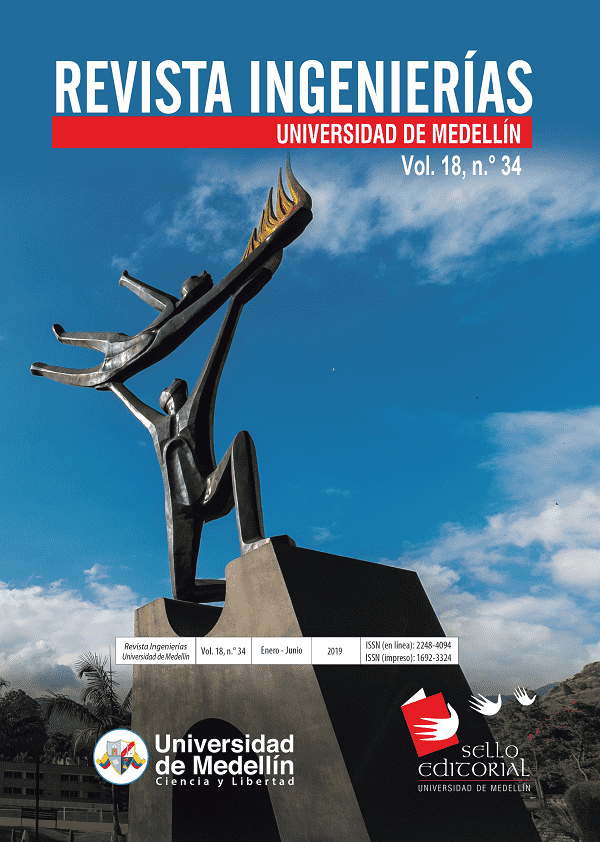Extraction and characterization of chitin scales from red tilapia (oreochromis sp.) from Huila, Colombia by chemical methods
Main Article Content
Abstract
Chitin is the second largest lineal biopolymer in the world. Recent advances suggest chitin can be obtained from fish scales. In this article, three different treatments were used to obtain chitin from red tilapia (Orechromis sp.) fish scales. All samples were insoluble in solvents and acid used. They also presented different percentages of carbon (3.27-55.80 %); oxygen (22.09-42.51 %); nitrogen (11.61-11.81 %); P (1.08-22.2 %); Ca (1.26-26.11 %); Na (0.53-1.02 %); and Mg (0.26-0.91 %). The 3,340-3,380 cm-1 bands shown in infrared spectra correspond to hydroxyl group of polymeric glucosamine bases and 1,415 -1,456 cm-1 peaks correspond to characteristic N-H bond of amide functional group. Images (SE) showed different dimensions of particles (0.1 -30 μm) and mean molecular masses, Mw, for Ch1, Ch2 and Ch3 were 1064.28, 1064.56 and 823.428, respectively, with a 1.0074 polydispersity.
Article Details
References
[1] S. Meza, 'Analizan procesos productivos y prospectivas de la acuicultura en el Huila'. Panorama Acuícola, [En línea], Disponible: https://panoramaacuicola.com/2017/08/19/analizan-procesos-productivos-y-prospectivas-de-la-acuicultura-en-el-huila/, 2017
[2] M. Arenas, Y. Vega, 'Estudio de factibilidad para la creación de una planta procesadora de harina de pescado en el departamento del Huila'. Tesis de especialización en negocios y finanzas internacionales. Universidad Escuela Administradora de Negocios, EAN. Neiva, Colombia, 2010.
[3] H. Ehrlich, M. Krautter, T. Hanke, P. Simon, C. Knieb, S. Heinemann, H. Worch, 'First evidence of the presence of chitin in skeletons of marine sponges. Part II. Glass sponges (Hexactinellida: Porifera),' Journal of Experimental Xoology(Mol. Dev. Evol.), vol. 308B, n.°4 pp. 473-83, 2007.
[4] D. Sukmawati, 'Antagonism mechanism of fungal contamination animal feed using phylloplane yeasts isolated from the bintaro plant (Cerbera manghas) Bekasi in Java, Indonesia,' International Journal of current Microbiology and Applied Sciences, vol. 5, n.° 2, pp. 63-74, 2016.
[5] J.I. Simionato, L.D. Guerra, M.K. Bulla, F.A. García, J. Carla, 'Application of chitin and chitosan extracted from silkworm chrysalides in the treatment of textile effluents contaminated with remazol dyes,' Acta Scientiarum, vol. 36, n° 4, pp. 693-98, 2014.
[6] W. Arbia, L. Arbia, L.Adour, A. Amrane, 'Chitin extraction from crustacean shells using biological methods - A review,' Food Technology and Biotechnology, vol. 51, n.° 1, pp. 12-25, 2013.
[7] S. Kumari, P.Rath, A.S Hari, T. Tiwari, 'Extraction and characterization of chitin and chitosan from fishery waste by chemical method,' Environmental Technology & Innovation, vol. 3, pp. 77-85, 2015.
[8] D. Sahoo, S. Sahoo, P. Mohanty, S. Sasmal, P.L. Nayak, 'Chitosan: a new versatile bio-polymer for various applications,' Designed Monomers and Polymers, vol. 12, pp. 377-404, 2009.
[9] R. Jayakumar, D. Menom, K. Manzoor, S.V. Nair, H. Tamura, 'Biomedical applications of chitin and chitosan based-nanomaterials- A short review,' Carbohydrate polymers, vol. 82, n.° 2, p. 227-232, 2010.
[10] H. Li. Zhang, W. Liu, 'Effects of chitin and its derivative chitosan on postharvest decay of fruits: A review,' Int. J. Mol. Sci., vol. 12, pp. 917-934, 2011.
[11] W. Suginta, P. Khunkaewla, A. Schulte, 'Electrochemical biosensor applications of polysaccharides chitin and chitosan,' Chemical reviews, vol. 113, n.° 4, p. 497-508, 2008.
[12] M. Kasaai, 'A review of several reported procedures to determinate the degree of N-acetylation for chitin and chitosan using infrared spectroscopy,' Carbohydrate Polymer, vol. 71, n.° 4, p. 497-508, 2008.
[13] V.S. Yeul, S.S. Rayalu, 'Unprecedent chitin and chitosan: A chemical overview,' Journal of polymers and the enviromental, vol. 21, pp. 606-614, 2013.
[14] B. S. Ndazi, C. Nyahumwa, J. Tesha, 'Chemical and thermal stability of rice husks against alkali treatment,' Bioresources, vol. 3, n.° 4, pp. 1267-1277, 2008.
[15] J. Uzun, O. Celik, 'Physicochemical and the comparison of chitin and chitin modified with maleic anhydride,' Oriental Journal of Chemistry, vol. 31, n.° 2, pp. 619-27, 2015.
[16] A. T. Ramaprasad, D. Latha, V. Rao, 'Synthesis and characterization of polypyrrole grafted chitin,' Journal of physics and chemistry of solids, vol. 104, pp. 169-74, 2017.
[17] S. Saharaee, J. M. Milani, B. Ghanbarzadeh, H. Hamishehkar, 'Effect of corn oil on physical, termal and antifungal properties of gelatin-based nano chitin,' LWT - Food Science and Technology, vol. 76, pp. 33-9, 2017.





